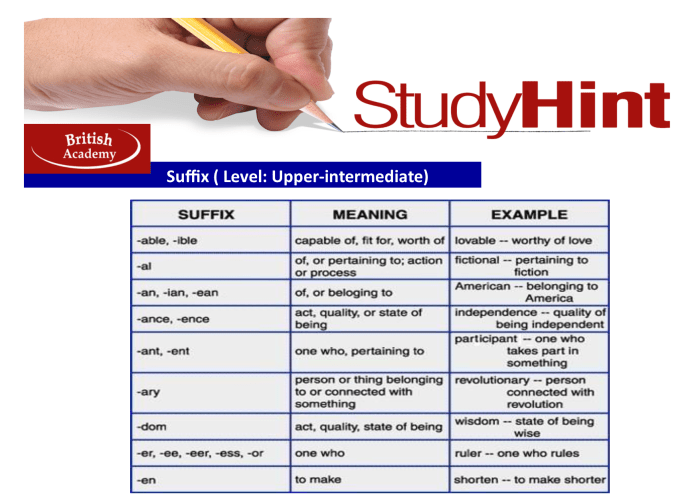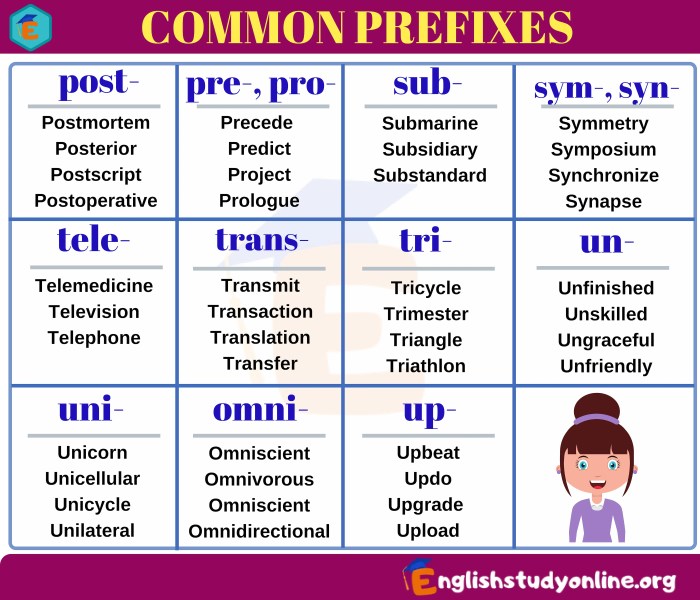Suffix with spat or form – Embark on a linguistic journey as we delve into the captivating world of suffixes, specifically those that grace words with the endings “spat” and “form.” From their diverse meanings to their intriguing historical evolution, these suffixes hold a treasure trove of linguistic insights waiting to be uncovered.
Our exploration will unveil the patterns and rules that govern the usage of “spat” and “form” as suffixes. We will dissect their grammatical and semantic properties, comparing and contrasting their applications in various contexts, from formal writing to creative prose.
Suffixes with “spat”

Words ending with “spat”
The suffix “spat” is commonly used to form verbs that indicate a sudden or forceful action. Here is a list of words that end with “spat”:
- Bespat – to spatter or splash something onto
- Conspat – to sprinkle or scatter something onto
- Dispat – to spread or scatter something
- Inspat – to spit or eject something
- Respat – to spit or eject something back
- Spat – to eject saliva from the mouth
- Upsat – to spit or eject something upwards
Meaning and usage
Words ending with “spat” often describe actions that are sudden, forceful, or involve the ejection of something. For example, “spat” can be used to describe the action of spitting saliva from the mouth, while “bespat” can be used to describe the action of splashing or scattering something onto a surface.
Patterns and rules
There are a few patterns and rules to keep in mind when using “spat” as a suffix:
- The suffix “spat” is typically added to verbs.
- Words ending with “spat” often describe actions that are sudden or forceful.
- The suffix “spat” can be used to form both transitive and intransitive verbs.
Suffixes with “form”

The suffix “form” is used to create words that describe shapes, structures, or systems. It can be added to nouns, verbs, and adjectives to change their meaning and function.
Nouns
When added to a noun, “form” creates a new noun that refers to the shape or structure of the original noun. For example:
- Circle + form = circle form
- Square + form = square form
- Triangle + form = triangle form
Verbs
When added to a verb, “form” creates a new verb that means “to make or create something.” For example:
- Create + form = create form
- Develop + form = develop form
- Shape + form = shape form
Adjectives
When added to an adjective, “form” creates a new adjective that means “having the shape or structure of the original adjective.” For example:
- Circular + form = circular form
- Square + form = square form
- Triangular + form = triangular form
Comparative Analysis of “spat” and “form” Suffixes

Suffixes are meaningful elements added to the end of words to modify their meaning or function. “Spat” and “form” are two common suffixes in the English language that serve distinct purposes. This analysis compares and contrasts their usage, identifying similarities and differences in their meanings, functions, and applications.
Similarities
Both “spat” and “form” are derivational suffixes, meaning they change the part of speech of the word they are added to. “Spat” typically transforms verbs into nouns, while “form” can convert verbs into nouns or adjectives.
Differences
Meaning and Function
“Spat” primarily denotes a small or insignificant amount or instance of something. It often conveys a sense of disdain or dismissal. For example, “a spat of rain” refers to a light drizzle, while “a spat of trouble” suggests a minor annoyance.
In contrast, “form” generally implies shape, structure, or appearance. It can also indicate a process or action. For instance, “the form of a cloud” describes its shape, while “the form of a government” refers to its structure.
Usage
“Spat” is commonly used in informal contexts, particularly in spoken language. It is often found in phrases like “a spat of bother,” “a spat of gossip,” or “a spat of ill-humor.”
“Form” has a wider range of usage, appearing in both formal and informal contexts. It is employed in various domains, including science, mathematics, literature, and everyday conversation.
Grammatical Properties
“Spat” forms nouns from verbs by adding “-spat” to the verb stem. For example, “splash” becomes “spat,” and “spatter” becomes “spatterspat.”
“Form” can create nouns from verbs by adding “-form” to the verb stem, as in “perform” to “performform.” It can also form adjectives from verbs by adding “-formable,” as in “deform” to “deformable.”
Examples of Word Usage
Suffixes “spat” and “form” can significantly alter the meaning and usage of words. Let’s explore some examples to understand their impact.
Suffix “spat”
- Aspat: An insult or remark that is contemptuous or disrespectful. (Noun)
- Backspat: To criticize or slander someone behind their back. (Verb)
- Forenspat: A conversation or dispute that is characterized by rude or angry exchanges. (Noun)
- Inspat: To cast aspersions or insults at someone. (Verb)
- Outspat: To surpass or excel someone in a competition or argument. (Verb)
Suffix “form”
- Contiform: Having the shape or form of a cone. (Adjective)
- Domeform: Having the shape or form of a dome. (Adjective)
- Gibbousform: Having a rounded or humped shape. (Adjective)
- Luniform: Having the shape or form of the moon. (Adjective)
- Stellform: Having the shape or form of a star. (Adjective)
Historical Evolution of Suffixes

The suffixes “-spat” and “-form” have a long and rich history in the English language. Both suffixes have undergone significant changes in usage and meaning over time, reflecting the evolving nature of the language.
Origins
The suffix “-spat” is believed to have originated from the Old English word “spat,” meaning “a spot or mark.” It was originally used to form nouns that referred to a small or insignificant thing, such as a “splatter” or a “speck.”
Over time, the suffix “-spat” came to be used more broadly to form nouns that referred to a variety of objects and concepts, including “spatula,” “spatter,” and “spasmodic.”The suffix “-form” has a similar origin, coming from the Latin word “forma,” meaning “shape or appearance.”
It was originally used to form nouns that referred to the shape or appearance of something, such as “uniform” or “deformity.” Over time, the suffix “-form” came to be used more broadly to form nouns that referred to a variety of concepts, including “platform,” “transform,” and “inform.”
To understand suffix with spat or form, it’s helpful to consider real-world examples. For instance, if you’re looking for information on the 2013 AP Biology Free Response Questions, you can find the answers here . This resource provides detailed explanations and guidance for each question, which can be incredibly valuable for students preparing for the exam.
Returning to our topic, suffix with spat or form can be further explored through examples in various fields, helping us grasp the concept more comprehensively.
Changes in Usage, Suffix with spat or form
The suffixes “-spat” and “-form” have both undergone significant changes in usage over time. The suffix “-spat” is now rarely used to form new words, and its use is largely confined to a few common words, such as “spatula” and “spatter.”
The suffix “-form,” on the other hand, is still used to form new words, although its use has become more specialized. It is now most commonly used to form nouns that refer to a particular shape or appearance, such as “uniform” or “deformity.”
Impact on the English Language
The suffixes “-spat” and “-form” have had a significant impact on the English language. They have helped to create a rich and diverse vocabulary, and they have played a role in the development of new words and concepts. The suffixes “-spat” and “-form” are a testament to the ever-evolving nature of the English language.
Suffixes in Different Contexts

The suffixes “spat” and “form” exhibit distinct usage patterns in different contexts, each carrying specific nuances and variations.
In formal writing, “spat” is typically employed to convey a sense of immediacy or spontaneity, often in the context of dialogue or informal narration. For instance, “She spat out the words with venom.” Conversely, “form” is commonly used in formal contexts to denote structure, order, or a set of rules, as in “The team’s performance was in top form.”
Informal Speech
In informal speech, “spat” is frequently used to express anger, frustration, or exasperation, often in a colloquial or slangy manner. For example, “He spat out a string of curses at the driver.” On the other hand, “form” is less commonly used in informal speech, but may occasionally appear to indicate a person’s appearance or condition, as in “She was in great form today.”
Technical Jargon
Within technical jargon, “spat” is rarely encountered. However, “form” is frequently employed to denote a specific shape, structure, or configuration, as in “The molecule takes the form of a tetrahedron.” This usage is particularly prevalent in scientific and engineering fields.
Creative Writing
In creative writing, “spat” is often used to create a sense of drama or tension, particularly in dialogue or action sequences. For instance, “The words spat from her mouth like venom.” “Form,” on the other hand, may be employed to describe the physical appearance or demeanor of a character, as in “Her form was tall and elegant.”
Quick FAQs: Suffix With Spat Or Form
What is the primary function of the suffix “spat”?
The suffix “spat” typically indicates a sudden or brief action, often with a negative connotation.
How does the suffix “form” differ in meaning from “spat”?
The suffix “form” has a broader range of meanings, including shape, structure, appearance, or a specific type of document.
Are there any common patterns in the usage of “spat” and “form” suffixes?
Yes, both suffixes tend to follow specific grammatical rules and patterns, which we will explore in detail.